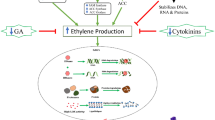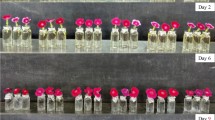Abstract
To understand the factors that induce floral senescence in Hibiscus syriacus L., we have investigated the effects of various chemical agents on flower senescence at two different flowering stages, before and after full bloom, as well as the relationship between flower longevity and endogenous ethylene production before full bloom. Treatments with ethylene, 1-aminocyclopropane-1-carboxylic acid (ACC), and ethephon enhanced floral senescence, while aminoethoxyvinylglycine (AVG) promoted flower longevity regardless of treatment timing. Although ethanol slightly extended flower longevity, abscisic acid (ABA), nitric oxide, boric acid and sucrose, which have been reported to affect flower longevity or senescence, had no effect on H. syriacus floral senescence. The polyamine spermine (SPM), methylglyoxal-bis(guanylhydrazone) (MGBG), an inhibitor of SPM biosynthesis, and cycloheximide (CHI) accelerated flower senescence when applied before full bloom, but had no effect when applied after full bloom. SPM, MGBG and CHI treatments resulted in enhanced ethylene production during flower opening, and the promotion of flower senescence is mediated by ethylene production prior to full bloom. Furthermore, endogenous ethylene, spontaneously produced before blooming, was closely associated with floral senescence. These results suggest that ethylene production during flower opening plays a key role in determining the timing of Hibiscus flower senescence.




Similar content being viewed by others
References
Borochov A, Woodson WR (1989) Physiology and biochemistry of flower petal senescence. Hortic Rev (Am Soc Hortic Sci) 11:15–43
Botha ML, Whitehead CS (1992) The effect of polyamines on ethylene synthesis during normal and pollination-induced senescence of Petunia hybrid L. flowers. Planta 188:478–483. doi:10.1007/BF00197038
Bouchereau A, Aziz A, Larher F, Martin-Tanguy J (1999) Polyamines and environmental challenges: recent developments. Plant Sci 140:103–125. doi:10.1016/S0168-9452(98)00218-0
Chae Y, Lee Y, Son KC (1995) Changes in ethylene production, polyamine levels and activities of SAM decarboxylase, ACC synthase and EFE during flower senescence of Hibiscus syriacus L. cv. Yeonggwang. J Korean Soc Hortic Sci 36:113–120
Downs CG, Lovell PH (1986) The effect of spermidine and putresine on the senescence of cut carnations. Physiol Plant 66:679–684. doi:10.1111/j.1399-3054.1986.tb05599.x
Drory A, Beja-Tal S, Borochov A, Gindin E, Mayak S (1995) Transient water stress in cut carnation flowers: effects of cycloheximide. Sci Hortic (Amsterdam) 64:167–175. doi:10.1016/0304-4238(95)00840-3
Ichimura K, Shimamura M, Hisamatsu T (1998) Role of ethylene in senescence of cut Eustoma flowers. Postharvest Biol Technol 14:193–198. doi:10.1016/S0925-5214(98)00039-8
Jiang WB, Mayak S, Halevy AH (1994) The mechanism involved in ethylene-enhanced ethylene synthesis in carnations. Plant Growth Regul 14:133–138. doi:10.1007/BF00025214
Kuiper D, Ribot S, Van Reenen HS, Marissen N (1995) The effect of sucrose on the flower bud opening of Madelon cut roses. Sci Hortic (Amsterdam) 60:325–336. doi:10.1016/0304-4238(94)00706-L
Kushad MM, Dumbroff EB (1991) Metabolic and physiological relationships between the polyamine and ethylene biosynthetic pathways. In: Slocum RD, Flores HE (eds) Biochemistry and physiology of polyamines in plants. CRC Press, Boca Raton, FL, pp 77–92
Lay-Yee M, Stead AD, Reid MS (1992) Flower senescence in daylily (Hemerocallis). Physiol Plant 86:308–314. doi:10.1034/j.1399-3054.1992.860218.x
Lee MM, Lee SH, Park KY (1997) Effects of spermine on ethylene biosynthesis in cut carnation (Dianthus caryophyllus L.) flowers during senescence. J Plant Physiol 151:68–73
Leshem YY, Wills RBH, Ku VVV (1998) Evidence for the function of the free radical gas-nitric oxide (NO)-as an endogenous maturation and senescence regulating factor in higher plants. Plant Physiol Biochem 36:825–833. doi:10.1016/S0981-9428(99)80020-5
Macnish AJ, Irving DE, Joyce DC, Vithanage V, Wearing AH, Lisle AT (2004) Variation in ethylene-induced postharvest flower abscission among Chamaleucium Desf. (Myrtaceae) genotypes. Sci Hortic (Amsterdam) 102:415–432. doi:10.1016/j.scienta.2004.05.002
Onoue T, Mikami M, Yoshioka T, Hashiba T, Satoh S (2000) Characteristics of the inhibitory action of 1, 1-dimethyl-4-(phenylsulfonyl)semicarbazide (DPSS) on ethylene production in carnation (Dianthus caryophyllus L.) flowers. Plant Growth Regul 30:201–207. doi:10.1023/A:1006324715438
Onozaki T, Ikeda H, Shibata M (2004) Video evaluation of ethylene sensitivity after anthesis in carnation (Dianthus caryophyllus L.) flowers. Sci Hortic (Amsterdam) 99:187–197. doi:10.1016/S0304-4238(03)00094-3
Overbeek J, Woltering E (1990) Synergistic effect of 1-aminocyclopropane-1-carboxylic acid and ethylene during senescence of isolated carnation petals. Physiol Plant 79:368–376. doi:10.1111/j.1399-3054.1990.tb06755.x
Panavas T, LeVangie R, Mistler J, Reid PD, Rubinstein B (2000) Activities of nucleases in senescing daylily petals. Plant Physiol Biochem 38:837–843. doi:10.1016/S0981-9428(00)01192-X
Pandey S, Ranade SA, Nagar PK, Kumar N (2000) Role of polyamines and ethylene as modulators of plant senescence. J Biosci 25:291–299. doi:10.1007/BF02703938
Petridou M, Voyiatzi C, Voyiatzis D (2001) Methanol, ethanol and other compounds retard leaf senescence and improve the vase life and quality of cut chrysanthemum flowers. Postharvest Biol Technol 23:79–83. doi:10.1016/S0925-5214(01)00102-8
Podd LA, van Staden J (2002) Physiological response and extension of vase life of cut carnation flowers treated with ethanol and acetylaldehyde. I. Chlorophyll content and carbohydrate status. Plant Growth Regul 38:99–105. doi:10.1023/A:1021267712167
Pun UK, Rowarth JS, Barnes MF, Heyes JA (2001) The role of ethanol or acetaldehyde in the biosynthesis of ethylene in carnation (Dianthus caryophyllus L.) cv. Yellow Candy. Postharvest Biol Technol 21:235–239. doi:10.1016/S0925-5214(00)00111-3
Ronen M, Mayak S (1981) Interrelationship between abscisic acid and ethylene in the control of senescence processes in carnation flowers. J Exp Bot 32:759–765. doi:10.1093/jxb/32.4.759
Seo SG, Kobayashi K, Fujihara S (2007a) The possible relationship between ethylene and polyamine metabolism during the flower opening and senescence, and their effect on flower longevity in Hibiscus syriacus L. Hortic Res Jpn 6:471–477
Seo SG, Shim IS, Usui K, Fujihara S (2007b) Analysis of polyamines, 1-aminocyclopropane-1-carboxylic acid and their conjugated forms in floral organs of Hibiscus syriacus L. J Jpn Soc Hortic Sci 76:149–156
Serrano M, Amorós A, Pretel MT, Martinez-Madrid MC, Romojaro F (2001) Preservative solutions containing boric acid delay senescence of carnation flowers. Postharvest Biol Technol 23:133–142. doi:10.1016/S0925-5214(01)00108-9
Shibuya K, Yoshioka T, Hashiba T, Satoh S (2000) Role of the gynoecium in natural senescence of carnation (Dianthus caryophyllus L.) flowers. J Exp Bot 51:2067–2073. doi:10.1093/jexbot/51.353.2067
Shvarts M, Weiss D, Borochov A (1997) Temperature effects on growth, pigmentation and post-harvest longevity of petunia flowers. Sci Hortic (Amsterdam) 69:217–227. doi:10.1016/S0304-4238(97)00015-0
Van Altvorst AC, Bovy AG (1995) The role of ethylene in the senescence of carnation flowers: a review. Plant Growth Regul 16:43–53. doi:10.1007/BF00040506
Vardi Y, Mayak S (1989) Involvement of abscisic acid during water stress and recovery in petunia flowers. Acta Hortic 261:107–112
Verlinden S, Garcia JJV (2004) Sucrose loading decreases ethylene responsiveness in carnation (Dianthus caryophyllus cv. White Sim) petals. Postharvest Biol Technol 31:305–312. doi:10.1016/j.postharvbio.2003.09.010
Walden R, Cordeiro A, Tiburcio AF (1997) Polyamines: small molecules triggering pathways in plant growth and development. Plant Physiol 113:1009–1013. doi:10.1104/pp.113.4.1009
Wang CY, Baker JE (1980) Extending vase life of carnations with aminooxyacetic acid, polyamines, EDU, and CCCP. Hort Sci 15:805–806
Woltering EJ, Van Doorn WG (1988) Role of ethylene and senescence of petals: morphological and taxonomical relationships. J Exp Bot 39:1605–1616. doi:10.1093/jxb/39.11.1605
Woodson WR, Hanchey SH, Chisholm DN (1985) Role of ethylene in the senescence of isolated hibiscus petals. Plant Physiol 79:679–683
Wulster C, Sacalis J, Janes HW (1982) The effect of inhibitors of protein synthesis on ethylene-induced senescence in isolated carnation petals. J Am Soc Hortic Sci 107:112–115
Author information
Authors and Affiliations
Corresponding author
Rights and permissions
About this article
Cite this article
Seo, SG., Kang, SW., Shim, IS. et al. Effects of various chemical agents and early ethylene production on floral senescence of Hibiscus syriacus L.. Plant Growth Regul 57, 251–258 (2009). https://doi.org/10.1007/s10725-008-9342-z
Received:
Accepted:
Published:
Issue Date:
DOI: https://doi.org/10.1007/s10725-008-9342-z




